Columnar trees are a great addition to any garden or landscape, adding color, beauty, and a touch of elegance. These tall, thin trees can create a stunning visual impact when lining driveways, growing along fences, or acting as a privacy hedge. Even container-grown columnar dwarf trees can be used to create a spectacular entrance near a doorway or gate. The narrow, upright growth habit of columnar trees makes them perfect for landscaping in both small and large yards.
Tall Skinny Trees for Landscaping
Columnar trees are a great addition to any garden, especially if you have limited space. One of their most notable characteristics is their fastigiate branches. These branches grow vertically, creating a narrow and upright shape. This rapid growth is what gives columnar trees their tall, thin appearance. They’re perfect for small gardens and can also be planted closely together to create a natural windbreak or privacy hedge.
If you’re looking for the best columnar trees to add to your garden, this article covers some of the most impressive ones, many of which have fastigiate growth. Each tree is accompanied by a description, scientific name, and image, making it easier for you to choose the perfect tall and slender tree for your landscaping needs.
Columnar Trees: Tall Skinny Trees With Their Picture and Name
While shade trees are excellent for providing shade, narrow trees can make a bold statement in your yard. These trees come in various sizes, with some being perfect for planting along a fence due to their thick and delicate leaves. Other types of tall columnar trees can be used as specimen trees or to create a natural barrier along a driveway.
Columnar Oak Tree (Quercus robur ‘Fastigiata’)

Fastigiate oak trees are an ideal choice for large properties as they can grow tall without spreading too much. These deciduous trees, such as the columnar oak ‘Fastigiata,’ are slow-growing but can reach heights of 50 to 65 feet (15 – 20 meters), making them unsuitable for small yards.
The columnar oak ‘Fastigiata’ is a narrow tree with a spread of only 15 feet (4 meters), making it different from traditional oak trees. If you have enough space for this oak tree, it will add beauty to your landscape with its dark green leaves turning into shades of gold and yellow during autumn. These upright oak trees thrive in USDA zones 5 – 8.
Narrow Kindred Spirit Oak Tree (Quercus x warei ‘Nadler’)

Columnar trees can provide beauty and functionality in any landscape, and the Kindred Spirit cultivar of tall columnar oak is a great option for those with limited space. With its fastigiate growth habit, this slender tree is perfect for small gardens or as an accent in larger yards. The dark green, glossy leaves turn a striking red in autumn, adding a pop of color to your landscape.
Compared to other columnar oak trees, the Kindred Spirit is relatively small, growing up to 30 feet (9 meters) tall and having a spread of just 4 feet (1.2 meters). It is a fast-growing deciduous tree that thrives in full sun and is suited for growing in USDA zones 4 through 7.
Red Maple ‘Walters Columnar’ Red Maple (Acer rubrum)
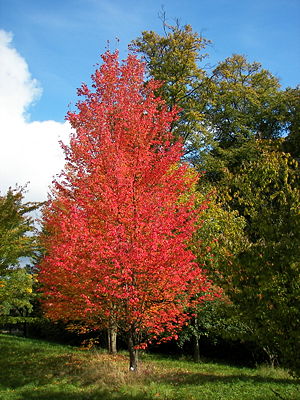
If you are looking for a tall, upright maple tree, the ‘Walters Columnar’ cultivar is a great choice. This fastigiate tree, also known as a scarlet maple, grows tall and slender, with beautiful red flowers blooming in the spring and rich green foliage turning a stunning deep red hue in the autumn.
Columnar red maples are a great addition to any yard, adding a strong vertical accent due to their growing pattern. Planting trees together can create a screening hedge. Pruning is necessary to keep the columnar maple at a manageable height of up to 60 feet (18 meters). Red maples can be grown in zones 3 through 9.
Other columnar red maple cultivars to consider include the fastigiate growth of ‘Columnare,’ the scarlet sentinelle tree with silvery bark and red fall foliage, and the Armstrong type of columnar maple tree.
Slender Silhouette Columnar Sweetgum Tree (Liquidambar styraciflua ‘Slender Silhouette’)
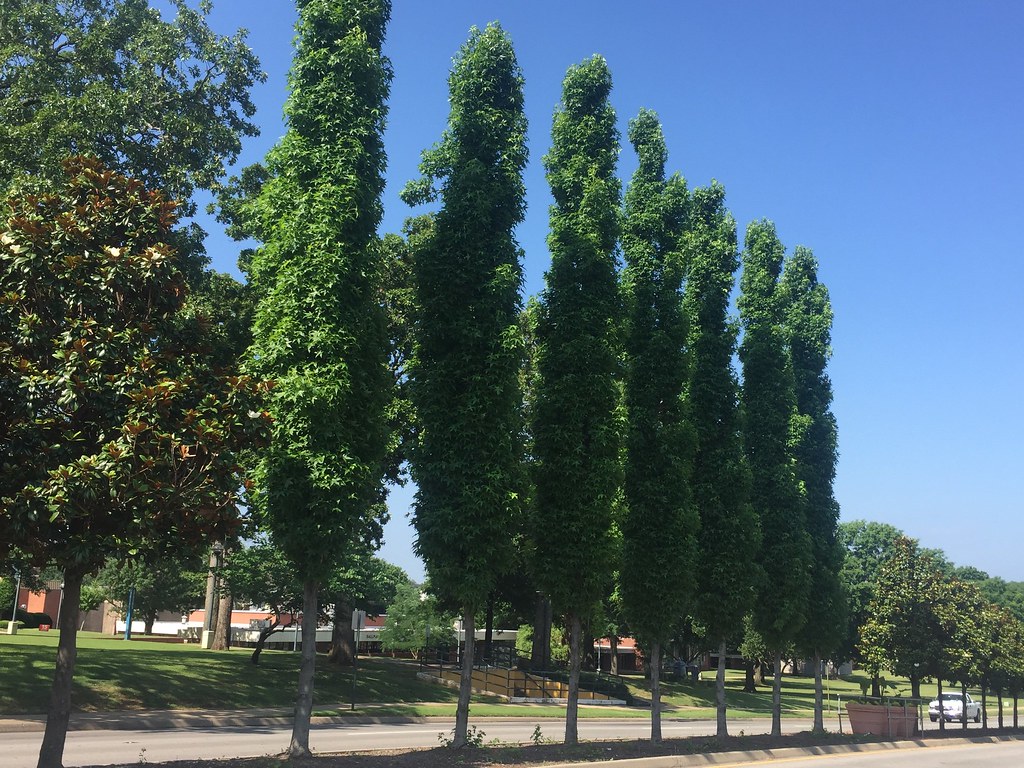
Slender Silhouette sweetgum is a tall and narrow tree that is part of the Liquidambar genus. Columnar sweetgums are attractive vertical trees with a basal area that is roughly the same size as the apex. The towering, slender tree resembles a bushy telegraph pole, thanks to its lush green leaves.
These large, slender trees can grow up to 50 feet (15 meters) tall with a diameter of 5 feet (1.5 meters). Slender Silhouette sweetgum trees are ideal for creating a strong vertical focal point in small to medium-sized yards. Planting these columnar trees together can also create a towering privacy screen in your yard. These trees prefer full sun and are best grown in zones 5 to 9.
Sky Pencil Holly (Ilex crenata ‘Sky Pencil’)
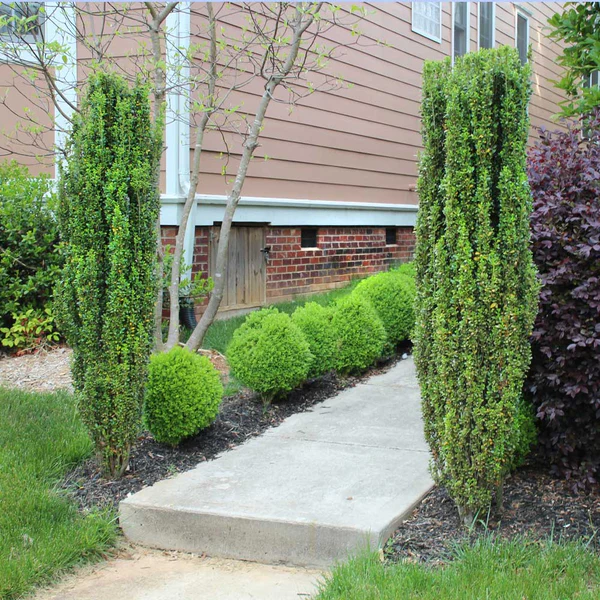
Sky Pencil Holly is a slow-growing evergreen tree that has a unique pencil-thin growth pattern. It is not a particularly tall tree and is ideal for small gardens due to its columnar growth habit. This tree can grow up to 6 to 10 feet (1.8 to 3 meters) in full sun, making it an excellent choice for garden centerpieces.
In late season, this tree produces tiny white flowers that add to its beauty. Sky Pencil trees can be grown in a row to create a narrow hedge or screen. They are versatile and can be used as borders, in pots, or planted along driveways. These columnar plants thrive in zones 6 to 8.
Dragon Lady Holly (Ilex x aquipernyi ‘Meschick’)
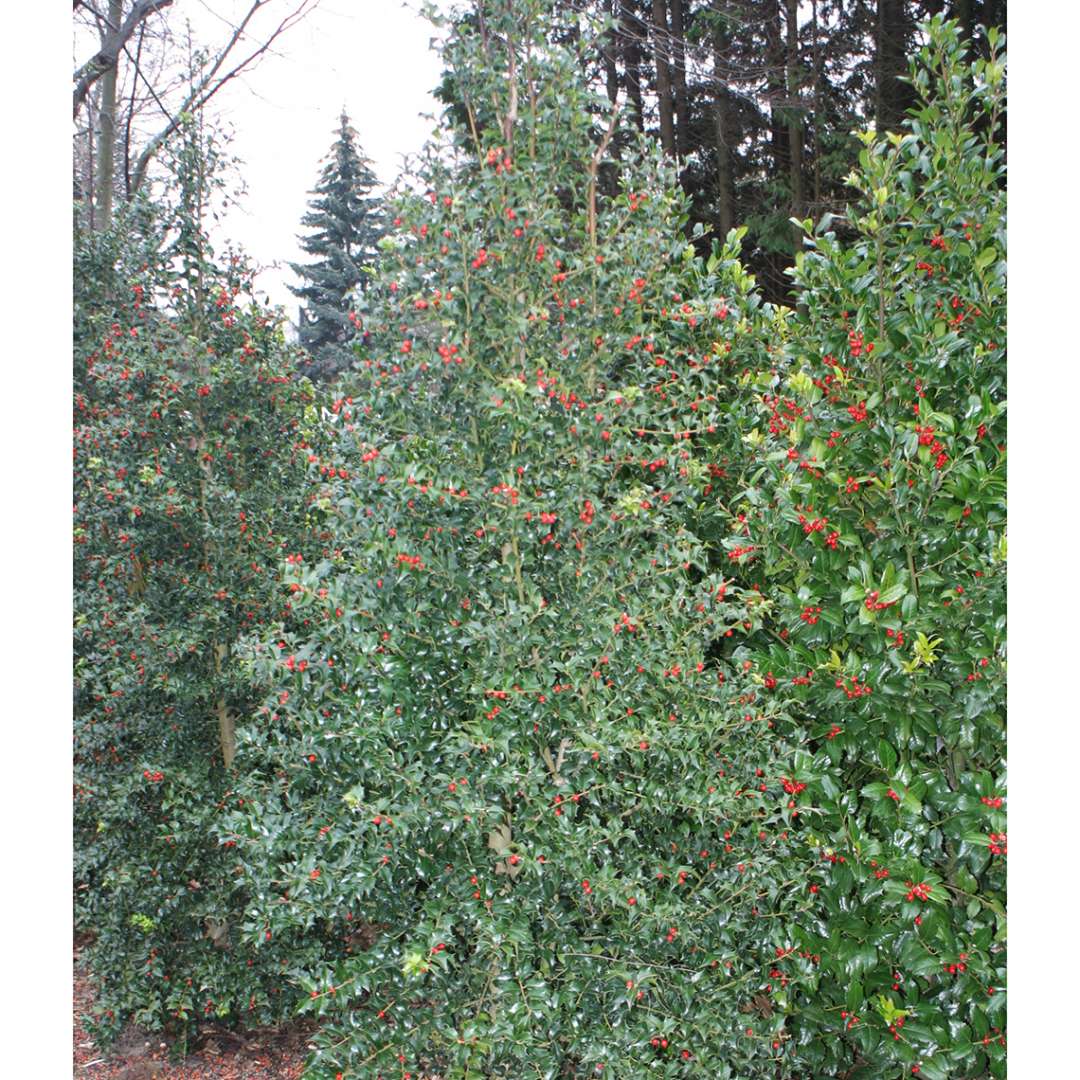
The ‘Dragon Lady’ is a holly tree that is perfect for privacy due to its conical shape and short, compact growth. This holly is an excellent choice for small gardens, as it can grow up to 20 feet (6 meters) tall and 5 feet (1.5 meters) wide without any pruning required to maintain its columnar form. The ‘Dragon Lady’ can grow well in both shaded and sunny areas, making it a versatile option. It is recommended for planting in zones 6 to 8.
Swedish Columnar Aspen (Populus tremula ‘Erecta’)

The Swedish aspen ‘Erecta’ is a beautiful columnar tree with pole-like growth that is commonly used as a tall, narrow windbreak tree. Its tall, slender form also makes it a great choice as a specimen tree, adding visual height to any landscape.
Despite reaching a height of up to 40 feet (12 meters), this aspen tree has a narrow spread of only 8 feet (2.5 meters), making it suitable for smaller yards. In the fall, the emerald green foliage turns into a beautiful golden yellow color. These slender trees can also be planted in a line to create a windbreak or screen.
Japanese Flagpole Flowering Cherry Tree (Prunus ‘Amanogawa’)

The Prunus ‘Amanogawa’, also known as the flagpole cherry tree, is a slender tree with a short growth habit in young trees. In the spring, it produces a beautiful and fragrant pinkish-white bloom, making it an excellent choice for a columnar flowering Japanese cherry tree. Young trees are more noticeable for their height and slenderness, but as they mature into cherry blossom trees, they develop a more vase-like shape. These flowering columnar trees can grow up to 25 feet (8 meters) tall and spread 4 to 8 feet (1 to 2 meters).
In addition to the flagpole cherry tree, there are many dwarf columnar fruit trees that are suitable for small gardens. Plum, apple, pear, and peach trees come in a variety of shapes, including columnar. True columnar trees, such as apple fruit trees, have a narrow upright growth habit that is not found in other types of fruit trees.
Columnar Tall Spruce Trees
Colorado Blue Spruce (Picea pungens ‘Fastigiata’)

The Fastigiata blue spruce cultivar is a cold-resistant evergreen tree that has a conical, tall growth habit. This columnar tree grows up to 20 feet (6 meters) in height and has bluish-green leaves, making it an elegant addition to any garden. Its upward growth pattern and pyramidal shape contribute to its beauty. This tree is hardy in cold climates, able to thrive in zone 2b and similar to other types of spruce trees.
Colorado Spruce (Picea pungens ‘Koster’)
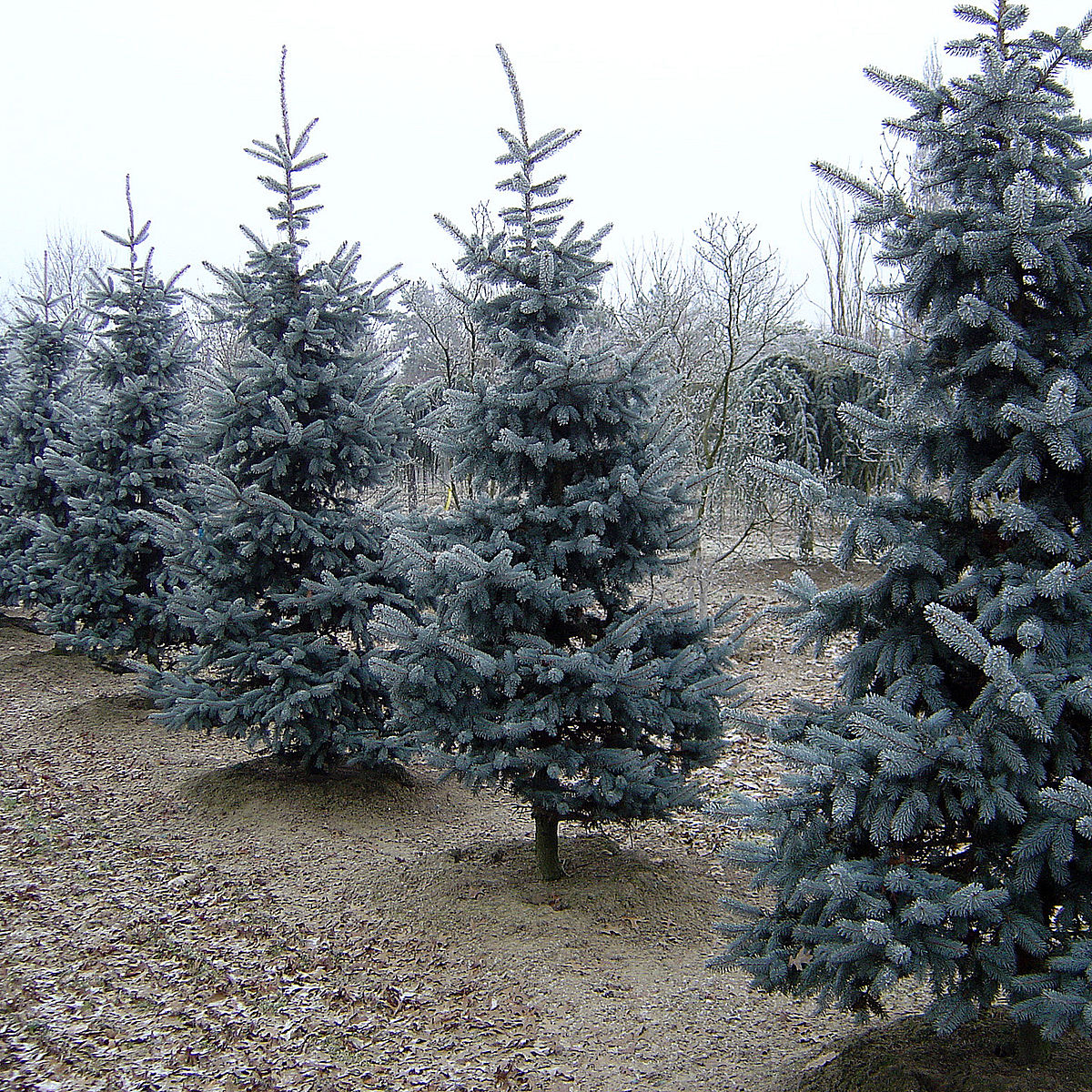
The ‘Koster’ cultivar of Colorado spruce is a stunning medium-sized tree with silvery-blue needles. It has a natural conical shape, which means it doesn’t require much pruning to maintain its form. This columnar evergreen is versatile and can be planted as a single tree to add a vertical accent or used in a row to create a narrow hedge. It grows best in full sun and is suitable for zones 2 to 8.
Columnar White Spruce (Picea glauca ‘Pendula’)

The weeping nature of the columnar white spruce makes it ideal for tight yards. The thin tree appears like a pole due to its stretching pendulous branches. This weeping white spruce is 12 to 40 feet (3.6 to 12 meters) tall and thrives in full sun. In a small yard, plant this evergreen tree to create a vertical emphasis.
Dwarf Alberta Spruce (Picea glauca ‘Conica’)
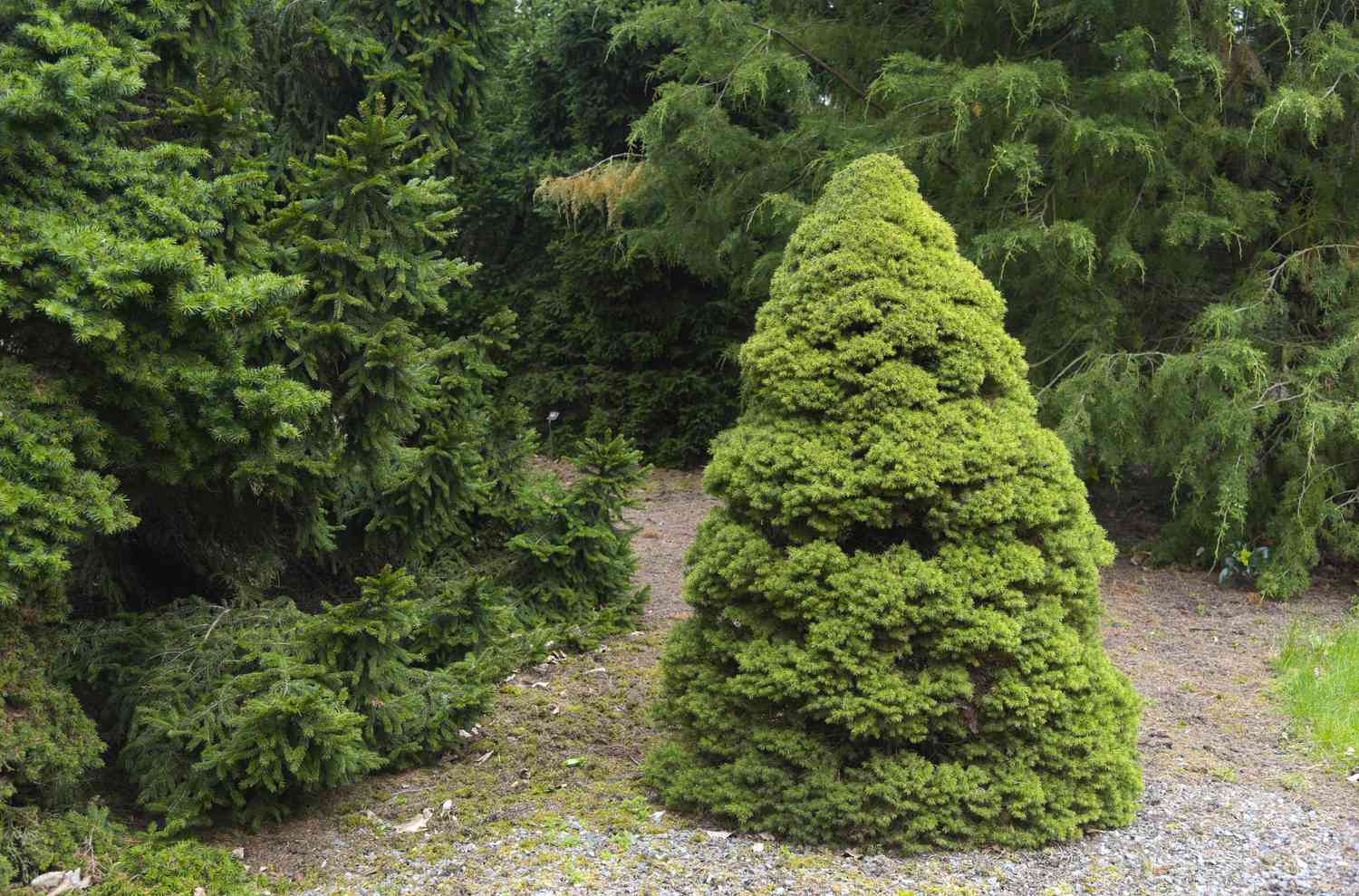
The Dwarf Alberta spruce is an excellent choice for those looking for a small, compact, columnar tree that grows slowly. This coniferous tree has cone-shaped branches and grows at a rate of only 4 inches (10 cm) per year, making it an ideal option for small gardens. You can grow this type of dwarf evergreen tree in a row to create a green privacy screening hedge, or in containers placed near doorways to create an elegant entrance.
Columnar Arborvitae (Thuja) Trees
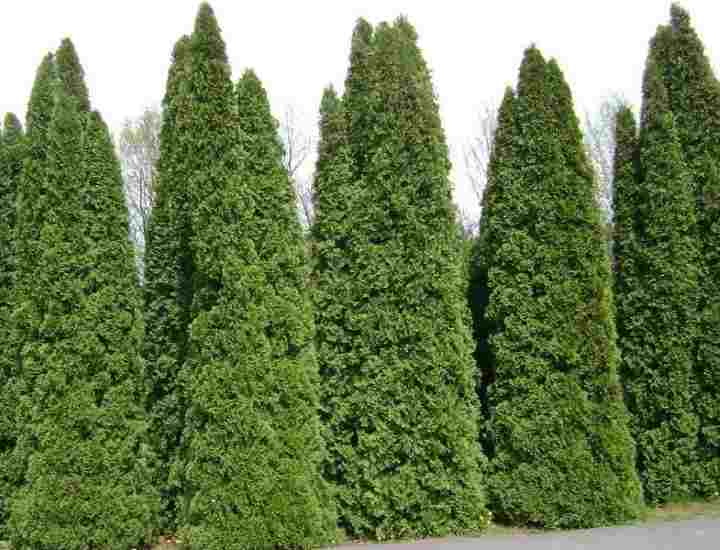
This artwork showcases Thuja occidentalis, also known as American arborvitae or Eastern arborvitae, which are two species of columnar trees that provide excellent privacy. Thuja is the scientific name for these columnar conifers, which are popular for creating “living walls” or privacy barriers.
American arborvitae (Thuja occidentalis) has a tall, extended pyramidal shape that makes it ideal for creating privacy barriers. The leaves are tightly compacted together, giving it a soft, scaly appearance. This low-maintenance evergreen tree can be grown in a row to provide year-round privacy.
Another popular option is the Arborvitae ‘Emerald Green’ (Thuja occidentalis ‘Smaragd’), which is a semi-dwarf evergreen tree with a narrow, conical shape. It grows to a height of 7 to 15 feet (2.5 to 4.5 meters) and is known for its emerald green foliage.
